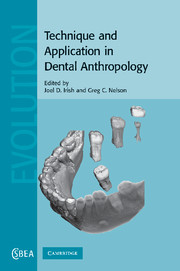Book contents
- Frontmatter
- Contents
- Contributors
- Acknowledgments
- Section I Context
- 1 Introduction
- 2 History of dental anthropology
- 3 Statistical applications in dental anthropology
- Section II Applications in assessing population health
- Section III Applied life and population history
- Section IV Forefront of technique
- Index
- References
1 - Introduction
Published online by Cambridge University Press: 12 September 2009
- Frontmatter
- Contents
- Contributors
- Acknowledgments
- Section I Context
- 1 Introduction
- 2 History of dental anthropology
- 3 Statistical applications in dental anthropology
- Section II Applications in assessing population health
- Section III Applied life and population history
- Section IV Forefront of technique
- Index
- References
Summary
Introduction
Introductory chapters in edited biological anthropology volumes often follow a stock, six-part formula: (1) explain why a component/ability/process of the human/non-human primate body/skeleton is of consequence, and can tell us so much about the origins/adaptation/affinities/health of an individual or population, (2) characterize the sub-field that studies said component/ability/process, (3) sing the myriad praises, and/or mention several shortcomings of that sub-field, (4) present an historical overview, (5) summarize the contributed chapters and relate how they tie in with parts 1–4, and (6) provide a vision of the sub-field's future direction(s). Such predictability may explain why many readers skip the Introduction, and head straight for the “meat” (i.e., the substantive chapters) of such books. For that reason we will leave out much of this standard material, with the exception of the chapter summaries, and primarily recount the genesis of the present volume; summaries are still presented to acknowledge the many talented contributors who made this volume possible, and to highlight and link together their diverse and, in some cases, cutting-edge dental research under a common, unifying theme, i.e., methodology.
In brief, it is unnecessary to expound on the qualities of the body/skeleton component covered in this volume – the dentition, or the sub-field of study used – dental anthropology, and/or, for that matter, the merits of such study (e.g., enamel is hard and preserves well, enamel does not remodel, the interaction between teeth and environment, the high genetic component in expression, teeth evolve slowly, both living and dead subjects can be directly compared, etc.); these issues were all previously detailed in innumerable books, including: Brothwell's (1963) Dental Anthropology, Kelley and Larsen's (1991) Advances in Dental Anthropology, and many others (e.g., Alt et al., 1998; Dahlberg, 1971; Harris, 1977; Hillson, 1986, 1996; Jordan et al., 1992; Kieser, 1990; Nichol, 1990; Scott, 1973; Scott and Turner, 1997).
- Type
- Chapter
- Information
- Technique and Application in Dental Anthropology , pp. 3 - 9Publisher: Cambridge University PressPrint publication year: 2008



